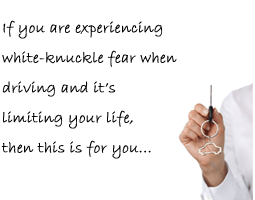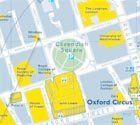DRIVING PHOBIA
Vehophobia, amaxophobia or driving fear and anxiety


What is driving phobia?
The physical symptoms of driving phobia
- Tightness in the chest
- Sweating (especially the palms) and shaking
- Physical tension (especially in the arms and hands)
- Light headiness or dizziness
- Shortness of breath or over-breathing
- Rapid heartbeat or palpitations
The psychological symptoms of driving phobia
- Might lose control
- Might do something stupid
- Might swerve
- The car might tip over
- Are being pulled or drawn to the left or right
- Are detached from the experience as if someone else is driving
- Have to focus and concentrate intensely
- Can’t tolerate distractions (engage in conversation, listen to the radio)
How people respond
- Slow right down (sometimes to a dangerously slow speed). This can often seem involuntary.
- Pull over, stop the car and try and calm down before driving on or having someone else take over.
- Drive on with great discomfort.
- Try and reduce their discomfort by forcing themselves to think of other things. Strategies including reciting the alphabet backwards, counting backwards or singing at the top of their voice.
Who it affects
What causes driving phobia?
Safety & avoidance behaviours
How we can help
DRIVING PHOBIA
DRIVING PHOBIA
Vehophobia, amaxophobia or driving fear
Vehophobia, amaxophobia or driving fear and anxiety


What is driving phobia?
The physical symptoms of driving phobia
- Tightness in the chest
- Sweating (especially the palms) and shaking
- Physical tension (especially in the arms and hands)
- Light headiness or dizziness
- Shortness of breath or over-breathing
- Rapid heartbeat or palpitations
The psychological symptoms of driving phobia
- Might lose control
- Might do something stupid
- Might swerve
- The car might tip over
- Are being pulled or drawn to the left or right
- Are detached from the experience as if someone else is driving
- Have to focus and concentrate intensely
- Can’t tolerate distractions (engage in conversation, listen to the radio)
How people respond
- Slow right down (sometimes to a dangerously slow speed). This can often seem involuntary.
- Pull over, stop the car and try and calm down before driving on or having someone else take over.
- Drive on with great discomfort.
- Try and reduce their discomfort by forcing themselves to think of other things. Strategies including reciting the alphabet backwards, counting backwards or singing at the top of their voice.
Who it affects
What causes driving phobia?
Safety & avoidance behaviours
How we can help
Frequent questions about driving phobia
Frequent questions about driving phobia
-
How common is driving phobia?
Driving phobia, or vehophobia, is surprisingly common and affects millions of people worldwide.
Estimates vary, but it’s thought that up to 20% of people experience some level of driving anxiety. And 10% of drivers meet the criteria for a diagnosed driving phobia.
So you are very far from alone but it can be changed when you get the right specialist help.
-
Is the Driving Phobia Cure program for me?
This clinically proven one-to-one treatment is for you if you:
- Experience high anxiety, fear and panic when driving.
- Fear you might lose control of your vehicle when highly anxious.
- Consistently avoid certain roads or driving situations because of your fear.
- Worry excessively beforehand about driving or being a passenger.
- Want to drive and feel comfortable and in control again
- Are serious about getting help to finally overcome your fear of driving.
-
How do people manage their fear of driving?
7 ways people manage their driving phobia:
Planning and driving alternative routes to avoid particular types of roads.
Using public transport which usually adds hours to their journeys.
Driving at unsociable times when the roads are clear to avoid traffic.
Relying on partners or friends to drive instead or take over en route.
Making excuses to avoid driving with friends and colleagues, or giving lifts
Finding other “reasons” to turn things down like jobs, invites and vacations involving driving.
Manipulating people and situations to avoid having to drive.
-
When does a fear of driving become a phobia?
Even if you've been driving for years, it's normal to feel a little anxious occasionally. But it’s only when you are consistently experiencing high anxiety and are compulsively avoiding driving, or certain driving situations, that a professional will likely diagnose a driving phobia. It’s the consistent avoidance that’s the hallmark of the phobia and what really impacts people’s lives and prompts them to get specialist help.
-
Will more driving lessons help me overcome my driving phobia?
The vast majority of people who develop a fear of driving are good competent drivers who have driven happily for many years. So it’s not a skills or competence thing: they still have the skills, it’s the fear that gets in their way. That’s why driving lessons are rarely helpful in treating driving phobia and why specialist therapy is the best approach.
-
What are the 10 most common triggers for driving phobia?
The 10 most uncomfortable situations for people with a fear of driving are:
- Motorways and multi-lane highways (most common)
- Multi-lane highways with no hard shoulder or emergency lane
- Fast busy roads (so having to drive at speed)
- Bridges, elevated roads and flyovers
- Overtaking (especially large vehicles)
- Being tail-gated or around aggressive drivers
- Feeling trapped in heavy traffic
- Being too close to particular vehicles (especially trucks)
- Hills (up or down)
- Driving on high or mountainous roads
These driving situations are usually avoided or else endured with great anxiety.
-
Do I need to remember how my driving phobia started?
Remembering how your driving phobia started is helpful but not critical to successful treatment. It’s the patterns and reactions you have now that are important.
With a driving phobia, it is usually very obvious when it starts. But the trigger event can be relatively minor, like feeling a bit uncomfortable when driving on a highway one day. It doesn't have to be a dramatic event or road accident that sets up the phobic response. In fact, that is very rarely the case because an accident might lead to short-lived post-traumatic stress, but not to a driving phobia.
-
What is a fear or phobia of driving called?
The clinical scientific name for a phobia of driving is vehophobia, which is defined as an intense and irrational fear of driving a vehicle. It can manifest in various ways, such as fear of losing control, fear of accidents, fear of being trapped or a fear of driving on certain roads or in specific situations.
Vehophobia is distinct from amaxophobia (the fear or phobia of being a passenger in a vehicle) and hodophobia (a more general fear of traveling).
It's important to remember that vehophobia, amaxophobia and hodophobia are all very treatable phobias with the right help.



